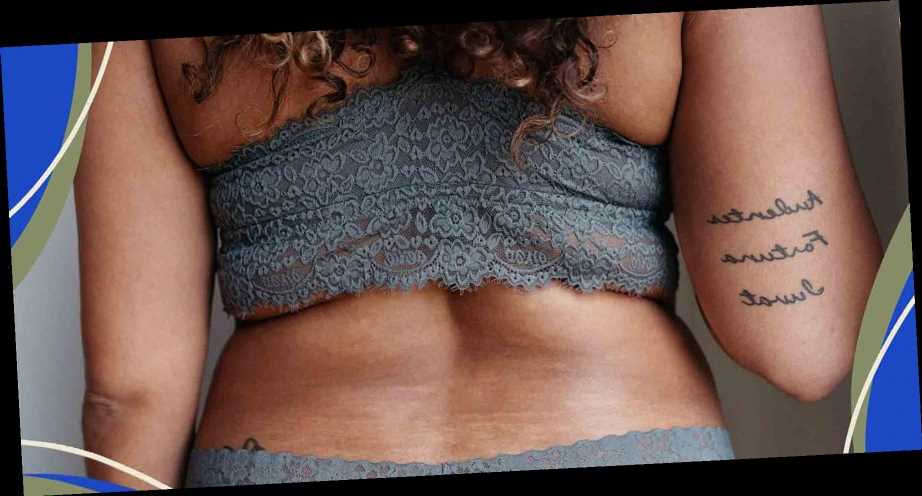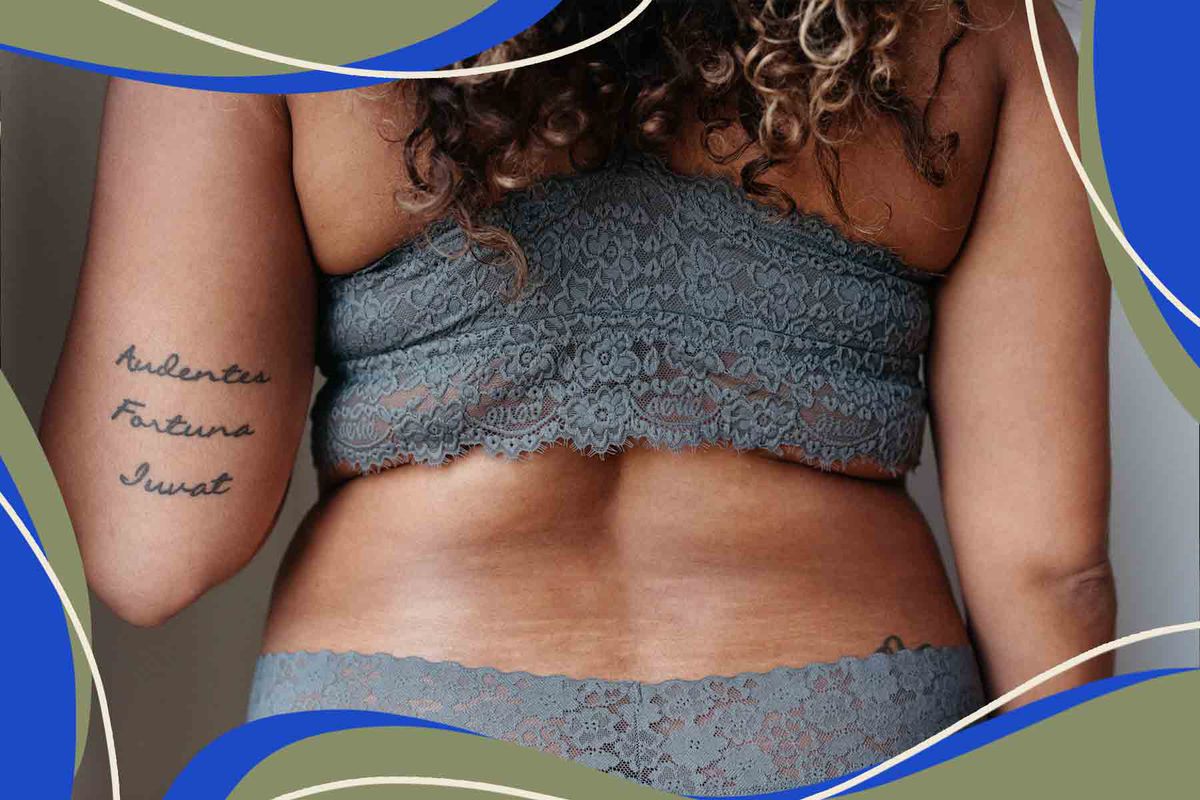
Stretch Marks Happen. Why Do Women Have to Love Them, Too?
04/09/2021A few years back, headlines declared a stretch mark revolution. As the body-positive movement became too big (and lucrative) to ignore, brands stopped airbrushing away models' stretch marks, and started putting them front and center.
For some, it was an opportunity to genuinely shift their values; for others, it was simply a marketing tool, used for press or to sell products, with no real follow-through, says Denise Bidot, a plus-size model whose unretouched Lane Bryant ad went viral in 2017 after it ran in the pages of Sports Illustrated, inspiring a slew of copycat campaigns from brands like Target and ASOS. Case in point: Bidot says she had another brand include her stretch marks in one ad campaign, only to airbrush them out for the next.
Regardless of a brand's motivation in showing stretch marks, simply seeing them has helped to normalize a very normal part of being a person whose body and skin changes over time. Bidot says "It's [naive] to think one ad campaign or viral moment can reprogram people's minds — but it can create a ripple effect,'' which helps women to accept something they may have been taught their entire lives they needed to hide or remove.
But rather than simply normalize stretch marks, we've done something else entirely. We've entered new territory where stretch marks aren't simply a thing that exists; they must be embraced and loved wholeheartedly for all they represent — whether it's childbirth, weight gain, or some other life transformation. This "celebration" can feel artificial, concocted out of marketing jargon. And it's also a slippery slope, making some women feel as though they don't love their bodies — or themselves — enough if they don't want to attend this extremely specific party.
We set out to report on exactly how women feel about stretch marks, and found that maybe they don't feel all that much. Skin is skin, it's a thing that gets marks on it sometimes, and sometimes it doesn't.
Here, we cut through the jargon to explore what stretch marks really are, what can and can't be done about them, and how women want the conversation to evolve past pure positivity into something that feels a bit more real.
Stretch marks can happen to anyone with skin — but women are most susceptible.
Although stretch marks tend to be more noticeable on darker skin types, stretch marks can happen to anyone, regardless of ethnicity, gender, or size. "Stretch marks are not related to weight itself," points out Cybele Fishman, M.D., a New York City-based dermatologist. "A very thin person can have them, and a very [large] person can have none."
Simply put, stretch marks happen when your body grows faster than your skin can keep up, causing the elastic fibers just under the surface of the skin to tear.
"Typically, when the skin stretches because of growth during puberty or weight gain, the skin can accommodate those changes, but in some cases, when stretching occurs more rapidly than the skin can adjust to it, these scars develop," explains Joshua Zeichner, M.D., director of cosmetic and clinical research in dermatology at Mount Sinai Hospital in New York City.
"The marks initially develop as wrinkly, raised streaks that can be red, purple, pink, reddish-brown or dark brown, depending on your skin color," says Boston-based dermatopathologist Gretchen Frieling, M.D. This is a result of the body healing itself and sending more blood flow to the area. These fresh scars will eventually fade and flatten, changing to a silvery, translucent, or white color over time — since this skin is void of hair follicles and normal pigment-containing cells.
While men can and do get stretch marks, women undergo more bodily changes that predispose them, explains New York City-based plastic surgeon Melissa Doft, M.D., clinical assistant professor of surgery at Weill Cornell Medical College. On top of the obvious fact that women's breasts and stomach are forced to expand quickly during pregnancy, changes in hormonal levels that can lead to weight gain (such as taking birth control pills or going through menopause) also make women more susceptible to stretch marks, Dr. Doft explains.
Dr. Frieling adds that areas of the body with a high fat content, where stretch marks are most likely to develop, tend to be more visible around women's clothing (swimwear especially) than men's.
Aside from gender, your genetics can determine your likelihood of developing stretch marks. Some people are genetically predisposed to them, meaning if your mom has stretch marks, you're likely to get them too, Dr. Zeichner says. While derms don't fully understand why, it may have something to do with overactivity of messengers in the genes responsible for scar development, he explains.
And that means stretch marks are largely outside of your control. Derms agree that while moisturizing and keeping your skin healthy is important, there's no lotion or oil that can override your genetics and prevent stretch marks from forming.
So, while men get stretch marks, too, it’s women that have to bear the brunt of this work — the creams, the celebration.
When I put out a call out on Instagram for people to share their unfiltered thoughts on stretch marks, unsurprisingly, new moms had the most to say. The general feeling? Annoyance — around stretch marks themselves and the pressure to feel positively about them. ("I don't want to 'earn my tiger stripes'," one woman wrote to me.) For others, compared to all the mental and physical changes your body goes through during pregnancy, stretch marks seem so minor.
"There's this vibe out there to love your body for everything it's going through and the truth is a lot of women don't love what pregnancy does to their body," writer Cassie Shortsleeve, who gave birth to her first child in June, DMs me.
She says she didn't develop stretch marks herself, but the pressure to worship her maternal body still rings true. "The reality is, not loving stretch marks or any other bodily change is normal — a lot of new moms feel the same way and it's just not talked about as much."
RELATED: Ashley Graham Showed Off Her Stretch Marks and Pregnant Belly in a Nude Photo
The fact that not all women are embracing their stretch marks is clear when you consider how many supposed stretch-mark curing creams and oils are on the market. At the same time, the number of women seeking derm treatments to try to remove their stretch marks has grown in the past few years, not decreased, multiple derms interviewed for this story said.
This extreme paradigm has led to conflicting messaging — should you love your stretch marks in public, but try to remove them with every cream out there in the privacy of your own bathroom? When Kourtney Kardashian recently shared a bathing suit photo to her brand poosh's Instagram account, she was praised for showing her stretch marks and "keeping it real" by not airbrushing them away. The caption, though? "Stretch marks: we've all got them. Looking to minimize the appearance of yours? Learn how at the link in our bio."
And while there should be no shame in using these products, the problem is they don’t actually work.
Creams and laser treatments can reduce the appearance of newly formed, red stretch marks while they are healing by targeting the pigment containing cells, explains Dr. Zeichner. But when it comes to stretch marks that have already developed and turned white, he emphasizes that they, like other scars, are permanent. Creams and oils might fade the appearance of stretch marks, he adds, but there's no data to suggest they work.
Dr. Fishman goes a step further: "I do not think any cream helps," she says — nor does she think lasers can help with white stretch marks either. She says patients can see modest improvement with several in-office microneedling treatments, but adds a caveat: "Patients need to understand there is nothing right now that will make them vanish."
Bidot can attest. Back when she was told she'd never be a lingerie model, before learning to simply "accept and love" her stretch marks, she says she spent years and thousands of dollars on every cream, oil, peel, and laser treatment out there to try to remove them.
RELATED: Everything You Need to Know About Laser Stretch Mark Removal
"If there was anything non-surgical I could do to eliminate them, I tried it. It was so much pain and money and — as you can tell — none of it worked," Bidot says. "It improved the texture a little, but they're still there. [Looking back], I think of how many trips to Hawaii or Europe I could have taken instead of the time I spent sitting in the doctor's office being tortured for no reason."
For derms faced with patients willing to shell out for a pricey treatment in their office, it comes down to managing expectations — and continuing the conversation of body positivity. "I explain to my patients that most of the images they see on social media are all retouched," Dr. Zeichner says. "Real women have stretch marks; these are just changes that skin go through."
So, why can’t we just feel ‘meh’ about stretch marks and move on?
For women who have dealt with stretch marks as a result of weight gain or weight loss as opposed to pregnancy, the emphasis on loving these scars can be equally unnerving.
"In college, I was over 200 pounds and I had stretch marks on my hips, midsection, tops of thighs, and sides of my chest near my boobs," says Emily Abbate, creator of the Hurdle podcast. "As a heavier set person, there were rarely instances where I felt comfortable showing those areas, so I was first cognizant of them after I lost weight," she says. (Stretch marks can become more pronounced after weight-loss since the skin can't 'bounce back' after after the collagen has been damaged, Dr. Zeichner says.
Compared to the physical work of losing 70 pounds (she started by walk-jogging a half-mile, until she could run a mile, and eventually, full marathons) and the emotional work of adjusting to being a smaller person, stretch marks weren't high on Abbate's list of things to love or worry about. "The stretch marks became something I noticed more, but not something I dwelled on," she says. "I've never in my life tried creams for them, ever."
Despite not actively trying to get rid of stretch marks, being inundated with "constant celebration" about them on social media can be overwhelming, she says. "It can make someone feel wrong for not feeling that way. But you aren't doing something wrong if you don't want to celebrate them," she says.
In fact, you're fine if you don't want to talk about them at all, either. "Two summers ago, I was in a pool with some people I knew when one of the women asked me, 'Do you do anything for those?'" Abbate recalls. "I was confused, and then I realized she was referencing my stretch marks. I was taken aback that it was even a point of conversation."
Perhaps the body-neutrality conversation needs to make its way around to stretch marks: It's OK not to love or hate them; you don't need to think about them at all. After all, constantly telling women that their stretch marks are beautiful and something to be proud of is still, well, reducing women to their stretch marks.
"This is the last thing we need to be worrying about. Why do we need to pick one more thing to be conscious of being judged or not judged on?" Abbate says. "This is just an aspect of being human — like balding or cellulite. These are all just things that happen."
State of Skin is our monthlong exploration of what women love, hate, and need to know about their skin — from the most common concerns to the best kept secrets in beauty.
Source: Read Full Article



